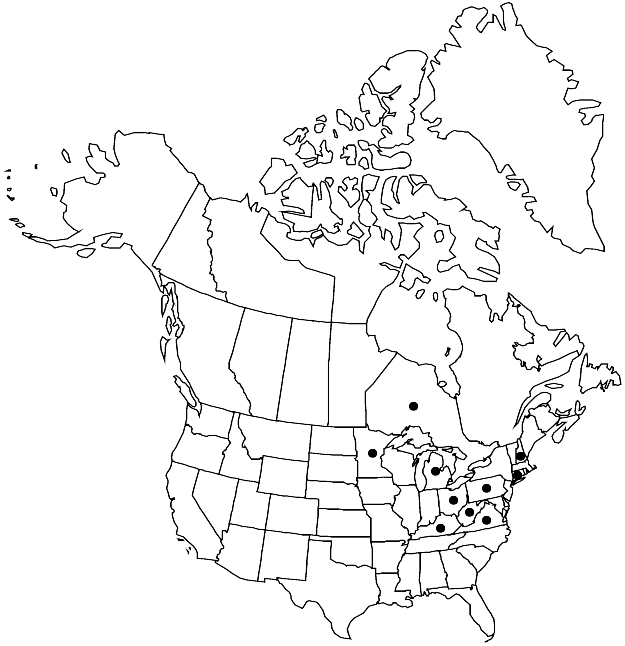Difference between revisions of "Cardamine impatiens"
Sp. Pl. 2: 655. 1753.
FNA>Volume Importer |
imported>Volume Importer |
||
| (5 intermediate revisions by 2 users not shown) | |||
| Line 6: | Line 6: | ||
|place=2: 655. 1753 | |place=2: 655. 1753 | ||
|year=1753 | |year=1753 | ||
| + | }} | ||
| + | |special_status={{Treatment/ID/Special_status | ||
| + | |code=I | ||
| + | |label=Introduced | ||
}} | }} | ||
|basionyms= | |basionyms= | ||
| Line 11: | Line 15: | ||
|name=Cardamine impatiens var. angustifolia | |name=Cardamine impatiens var. angustifolia | ||
|authority=O. E. Schulz | |authority=O. E. Schulz | ||
| + | |rank=variety | ||
}} | }} | ||
|hierarchy=Brassicaceae;Brassicaceae tribe Cardamineae;Cardamine;Cardamine impatiens | |hierarchy=Brassicaceae;Brassicaceae tribe Cardamineae;Cardamine;Cardamine impatiens | ||
| Line 26: | Line 31: | ||
|elevation=0-200 m | |elevation=0-200 m | ||
|distribution=Ont.;Conn.;Ky.;Mich.;Minn.;N.H.;Ohio;Pa.;Va.;W.Va.;Eurasia;introduced also in South Africa. | |distribution=Ont.;Conn.;Ky.;Mich.;Minn.;N.H.;Ohio;Pa.;Va.;W.Va.;Eurasia;introduced also in South Africa. | ||
| + | |introduced=true | ||
|tables= | |tables= | ||
|references= | |references= | ||
| Line 34: | Line 40: | ||
-->{{#Taxon: | -->{{#Taxon: | ||
name=Cardamine impatiens | name=Cardamine impatiens | ||
| − | |||
|authority=Linnaeus | |authority=Linnaeus | ||
|rank=species | |rank=species | ||
| Line 49: | Line 54: | ||
|publication title=Sp. Pl. | |publication title=Sp. Pl. | ||
|publication year=1753 | |publication year=1753 | ||
| − | |special status= | + | |special status=Introduced |
| − | |source xml=https:// | + | |source xml=https://bitbucket.org/aafc-mbb/fna-data-curation/src/2e0870ddd59836b60bcf96646a41e87ea5a5943a/coarse_grained_fna_xml/V7/V7_729.xml |
|tribe=Brassicaceae tribe Cardamineae | |tribe=Brassicaceae tribe Cardamineae | ||
|genus=Cardamine | |genus=Cardamine | ||
Latest revision as of 22:35, 5 November 2020
Biennials or, rarely, annuals; usually glabrous, rarely sparsely pubescent basally. Rhizomes absent. Stems erect, (angled, sometimes flexuous), unbranched basally, usually branched distally, (1.2–)2–6.5(–9) dm. Basal leaves (often withered by flowering), rosulate, similar to cauline, with fewer distal leaflets. Cauline leaves 9–24, (9–)13–25-foliolate, petiolate, leaflets petiolulate; petiole 2–6 cm, base auriculate (auricles to 10 × 2.2 mm); lateral leaflets similar to terminal, blade often smaller; terminal leaflet (petiolule to 0.5 cm), blade orbicular, obovate, ovate, or lanceolate, 1–4(–5) cm × 5–17 mm, margins entire or 3–5(–9)-toothed or -lobed. Racemes ebracteate. Fruiting pedicels divaricate or ascending, 3.5–12(–15) mm. Flowers: sepals oblong, 1.2–2(–2.5) × 0.7–1(–1.2) mm, lateral pair not saccate basally; petals (rarely absent), white, oblanceolate, 1.5–4(–5) × 0.6–1.2 mm; filaments 2–3(–4) mm; anthers ovate, 0.3–0.5 mm. Fruits linear, (torulose), (1–)1.6–3(–3.5) cm × 0.9–1.5 mm; (valves glabrous or, rarely, pilose); ovules 10–30 per ovary; style 0.6–1.6(–2) mm. Seeds brown, oblong, 1.1–1.5 × 0.8–1 mm, (compressed, sometimes narrowly winged apically). 2n = 16.
Phenology: Flowering May–Jul.
Habitat: Streamsides, slopes, roadsides, fields, disturbed areas
Elevation: 0-200 m
Distribution

Introduced; Ont., Conn., Ky., Mich., Minn., N.H., Ohio, Pa., Va., W.Va., Eurasia, introduced also in South Africa.
Discussion
Selected References
None.